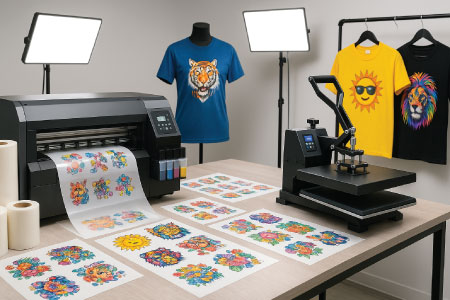Why DTF Transfer Printing Quality Matters
Direct-to-Film (DTF) transfer printing has taken the custom apparel world by storm. Its ability to produce vibrant, durable, and detailed prints on almost any fabric makes it one of the most versatile printing technologies available today.
However, just like any printing method, mistakes in DTF transfer printing can lead to wasted materials, poor-quality results, and unhappy customers. For businesses, these errors can cost time, money, and credibility.
At DTFSuperPrint.com, we’ve seen the difference between a flawless DTF print and a failed one — and most failures come from avoidable mistakes.
In this guide, we’ll walk you through the most common DTF printing errors, how to prevent them, and tips to achieve consistent, high-quality results with every print.
Choosing the Wrong Film and Powder
One of the first and most crucial steps in DTF printing is selecting the right PET film and adhesive powder. Using low-quality or incompatible materials can lead to:
- Cracked prints
- Poor adhesion
- Faded colors after washing
How to Avoid This Mistake:
- Use premium PET films designed for DTF (thickness: 0.75–0.80 mm for better ink absorption).
- Always store film in a cool, dry place to prevent moisture damage.
- Choose high-quality hot-melt powder that matches your film and ink type.
Pro Tip from DTFSuperPrint: Stick with reputable suppliers who specialize in DTF printing materials, and test a small batch before committing to bulk orders.
Incorrect Printer Settings
Even the best materials will fail if your printer settings aren’t optimized. Common mistakes include:
- Wrong ink saturation levels
- Incorrect ICC color profiles
- Printing at the wrong resolution
How to Avoid This Mistake:
- Use the manufacturer’s recommended ICC profile for your inks.
- Maintain print resolution between 1440×1440 dpi for sharp images.
- Adjust ink limits to prevent oversaturation (which can cause smudging).
DTFSuperPrint Tip: Keep a log of your most successful print settings so you can replicate results easily.
Poor Artwork Preparation
A high-quality print starts with high-quality artwork. Low-resolution designs or poor color separation can ruin the final product.
How to Avoid This Mistake:
- Prepare artwork at 300 DPI in RGB color mode for vibrant colors.
- Use transparent backgrounds for designs to avoid unwanted edges.
- Double-check that all text and details are legible at the final print size.
Pro Tip: Always do a soft proof to preview colors before printing.
Skipping White Ink Underbase
White ink acts as the foundation for your DTF prints, ensuring colors pop on dark fabrics. Skipping or improperly printing the underbase can cause colors to appear dull or invisible.
How to Avoid This Mistake:
- Enable white ink underbase in your RIP software.
- Ensure even coverage without gaps.
- Avoid overprinting white, which can make the design thick and stiff.
Inconsistent Powder Application
Uneven hot-melt powder application can cause patchy adhesion and peeling prints after washing.
How to Avoid This Mistake:
- Apply powder evenly using a shaker machine or careful hand application.
- Shake off excess powder to avoid clumping.
- Bake powder at 320–340°F for 2–3 minutes or as per manufacturer’s instructions.
Improper Curing
Incorrect curing can cause prints to crack, fade, or not adhere properly to the fabric.
How to Avoid This Mistake:
- Use a curing oven for consistent heat distribution.
- Follow exact temperature and time guidelines.
- Avoid overheating, as this can make prints brittle.
Using the Wrong Heat Press Settings
The heat press stage is critical. The wrong temperature, pressure, or pressing time can ruin the transfer.
How to Avoid This Mistake:
- Use 300–325°F for 10–15 seconds (check your material type).
- Apply medium to firm pressure.
- Pre-press garments to remove moisture and wrinkles before application.
Ignoring Fabric Type Compatibility
DTF printing works on a wide range of fabrics, but not every fabric behaves the same.
How to Avoid This Mistake:
- Test prints on new fabric types before bulk production.
- Adjust press time and temperature for heat-sensitive fabrics.
- Use Teflon sheets or parchment paper to protect delicate fabrics.
Not Maintaining the Printer
A dirty printhead, clogged nozzles, or expired inks can cause major print issues.
How to Avoid This Mistake:
- Perform daily nozzle checks.
- Store inks properly to avoid drying.
- Schedule weekly cleanings for the capping station, wiper blade, and printhead.
Neglecting Environmental Conditions
Humidity and temperature can greatly affect DTF printing quality.
How to Avoid This Mistake:
- Maintain a stable environment (40–60% humidity, 68–75°F temperature).
- Use dehumidifiers or humidifiers as needed.
- Keep PET films sealed until use to avoid moisture absorption.
Overlooking Peel Method
DTF transfers can be hot peel or cold peel, and mixing them up can cause damage.
How to Avoid This Mistake:
- Always check if your film is hot peel or cold peel.
- For cold peel, wait 15–30 seconds before peeling.
- Peel slowly and evenly to avoid lifting edges.
Skipping Test Prints
Jumping straight to full production without test prints can be costly.
How to Avoid This Mistake:
- Always run a test print to check colors, registration, and adhesion.
- Make adjustments before starting bulk production.
Poor Washing Instructions for Customers
Even a perfect print can fail if customers wash it incorrectly.
How to Avoid This Mistake:
- Provide care labels: Wash inside out, cold water, gentle cycle.
- Avoid bleach and fabric softeners.
- Air dry or tumble dry on low heat.
Not Tracking Supplies
Running out of film, powder, or ink mid-production can cause delays.
How to Avoid This Mistake:
- Maintain an inventory checklist.
- Order supplies before they run critically low.
Ignoring Continuous Learning
DTF technology is constantly evolving. Not keeping up with updates can hold back your business.
How to Avoid This Mistake:
- Follow industry leaders and forums.
- Experiment with new techniques.
- Attend trade shows or training sessions.
Perfect DTF Prints Start with Consistency
Avoiding these common DTF printing mistakes can save you time, money, and frustration — while keeping your customers happy with flawless, long-lasting prints.
At DTFSuperPrint.com, we’re committed to providing top-quality DTF materials and expert tips to help you achieve perfect results every time.
If you want vibrant, durable, and professional prints, follow these guidelines — and remember, success in DTF printing is all about preparation, precision, and quality control.

